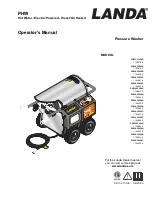
24 • ENGLISH
f
To stop operation of the appliance, release the trigger
(Fig. D15).
f
The appliance is fitted with a pressure switch.
f
The motor does not start unless the trigger of the gun
(Fig. D15) is pressed.
Caution! During operation the appliance must be
positioned as shown in (Fig. D) on a sturdy, stable surface.
Caution! Do not obstruct the appliance’s cooling vents
during operation.
If the appliance is to be out of use for more than
10 min., it should always be switched off using
the ON/OFF switch (Fig. D14).
TSS Models - In TSS models with automatic delivery flow
cut-o system:
a. When the gun trigger is released, the dynamic
pressure automatically cuts out the motor (see Fig. D);
b. When the gun trigger is depressed, the automatic
drop in pressure starts the motor and the pressure
is restored after a very slight delay;
c. If the TSS is to function correctly all gun releasing
and depressing operations, must be performed at
intervals of not less than 4 - 5 seconds at least.
On three-phase models for professional use: at first use,
start the appliance for a very short time to check that the
motor is running in the correct direction. If the motor fan is
turning anti-clockwise, exchange two of the three phase
wires (L1, L2, L3) in the electrical plug.
Note: To prevent damage to the appliance, do not allow
it to oper- ate dry and when running do not stop the water
jet for more than 10 minutes at a time (for models without
TSS device).
Operating in low pressure mode and with
detergent
f
Unwind the high pressure hose to the required length.
f
When using detergent, the adjustable nozzle must be
set on “ “
f
Set the nozzle (Fig. A1) in low pressure mode
(fully forward (Fig. C).
f
Press the trigger of the gun (Fig. D15) to obtain a
jet of water.
f
Hold the gun open for a few seconds.
f
Turn the master switch (Fig.D14) to (ON/I).
f
To stop operation of the appliance, release the trigger
(Fig. D15).
f
The motor does not start unless the trigger of the gun
(Fig. D15) is pressed.
Caution! During operation the appliance must be
positioned as shown in Fig. D on a sturdy, stable surface.
Adjusting the detergent
Detergent flow is adjusted using the regulator (13).
Stopping the appliance
1. Set the starter device switch off (OFF/0).
2. Depress the gun trigger and discharge the residual
pressure inside the hoses.
3. Engage the gun safety catch (11).
Restarting
1. Release the safety catch (11).
2. Depress the gun trigger and discharge the residual air
inside the hoses.
3. Set the starter device on (ON/I).
Storage
1. Switch the appliance off (OFF/0).
2. Remove the plug from the socket.
3. Turn off the water supply tap.
4. Discharge the residual pressure from the gun until all
the water has come out of the nozzle.
5. Drain the detergent tank.
6. Engage the gun safety catch (11).
Recommended cleaning procedure
Dissolve dirt by applying the detergent mixed with water to
the surface while still dry. When dealing with vertical surfaces
work from the bottom upwards. Leave the detergent to act for
1-2 minutes but do not allow the surface to dry. Starting from
the bottom, use the high pressure jet at a minimum distance
of 30cm. Do not allow the rinse water to run onto unwashed
surfaces. In some cases, scrubbing with brushes is needed to
remove dirt. High pressure is not always the best solution for
good washing results, since it may damage some surfaces.
The finest adjustable nozzle jet setting or the rotopower
nozzle should not be used on delicate or painted parts, or
on pressurised components (e.g tyres, inflation valves, etc.).
Effective washing depends on both the pressure and volume of
the water used, to the same degree.
MAINTENANCE (Fig. E)
Any maintenance operations not covered by this chapter should
be carried out by an Authorized sales and service Centre.
Caution! Always disconnect the plug from the power
socket before carrying out any work on the appliance.
Cleaning the nozzle
1. Disconnect the lance from the nozzle.
2. Remove any dirt deposits from the nozzle hole using
the tool (8).
Содержание PW2100
Страница 3: ...FIG B 3 6 1 5 2 Ø13 4 ...
Страница 4: ...2 1 2 1 FIG C FIG D 12 13 14 14 14 11 11 15 15 ...




































